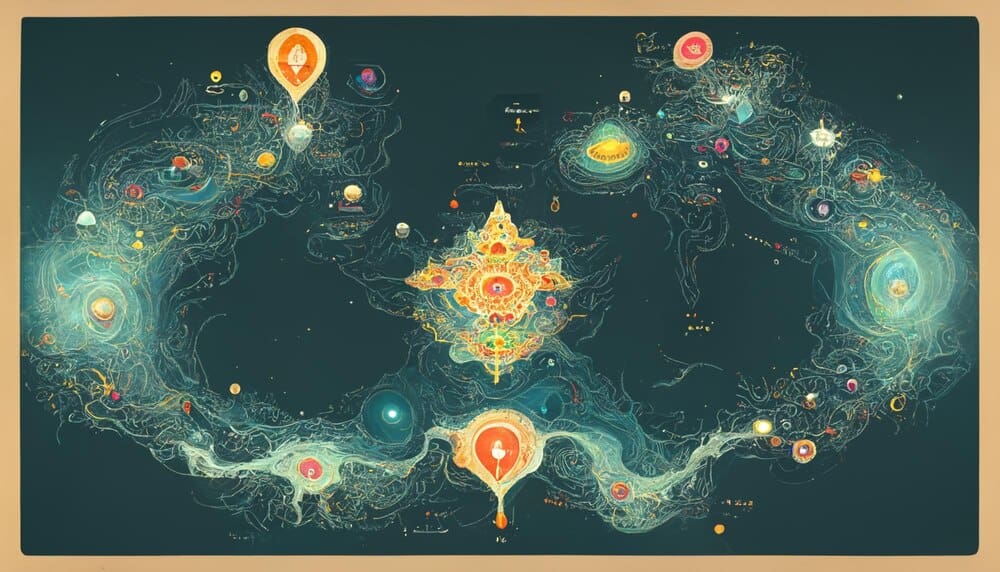In the intricate celestial language of Vedic Astrology, a ‘Yoga’ represents the most profound form of planetary communication, signifying a special combination or union of planets that creates a specific, predictable result in an individual’s life. These yogas, formed by the placement, association, or aspect of planets within a natal chart at the moment of birth, are the key to unlocking the chart’s deeper narrative, revealing the potential for immense success, wealth, spiritual growth, or significant challenges. Understanding the yogas present in one’s horoscope is to understand the core karmic script one is born with, offering unparalleled insight into personal destiny, inherent talents, and the timing of major life events.
At its heart, a yoga is more than a simple planetary placement; it is a specific configuration that must meet defined criteria. This “union” can occur through several mechanisms. Planets can be in conjunction (in the same house), in mutual aspect, in each other’s signs (a relationship called parivartana), or through their lordship over specific houses. The result of this planetary synergy is a focused energy that shapes a particular area of life, for better or for worse, far more powerfully than any single planet could alone.
However, the mere presence of a yoga is only the beginning of the story. Its true power and the nature of its manifestation depend critically on the strength of the planets involved. Strong, dignified planets in benefic houses will deliver the promised results of a positive yoga with brilliance and ease. Conversely, a yoga formed by weak, afflicted, or debilitated planets may fail to deliver its potential or, in some cases, produce contrary results. The timing of a yoga’s activation is also paramount, governed by the Vimshottari Dasha system, which dictates when the planetary periods that form the yoga will be operational, bringing its karmic promise to the forefront of life experience.
The Royal Road: Raja Yogas
Among the most sought-after and powerful combinations in Vedic Astrology are the Raja Yogas, or “Royal Combinations.” These yogas bestow upon an individual status, authority, success, recognition, and the capacity to lead. They are the astrological markers of individuals who rise to prominence in their chosen fields, be it politics, business, arts, or any other domain of public life.
The classical formation of a Raja Yoga involves a connection between the lord of a Kendra (angular) house and the lord of a Trikona (trine) house. The Kendra houses—the 1st, 4th, 7th, and 10th—represent the pillars of life: self, home and happiness, relationships, and career, respectively. The Trikona houses—the 1st, 5th, and 9th—are houses of fortune and grace, representing self, creativity and intelligence, and higher wisdom and luck. When the planet ruling an action-oriented Kendra house connects with a planet ruling a fortune-blessed Trikona house, a powerful synergy of effort and luck is created.
Dharma Karmadhipati Yoga
The most potent of all Raja Yogas is the Dharma Karmadhipati Yoga. This is formed by the association of the 9th lord (Dharma, or life purpose and fortune) and the 10th lord (Karma, or career and action in the world). When these two planetary energies combine, a person’s career becomes their life’s purpose. They pursue their work with a deep sense of meaning, and their actions are guided by righteousness and fortune, leading to incredible and lasting success, fame, and honor.
The Flow of Fortune: Dhana Yogas
Dhana Yogas are the “Wealth Combinations” that indicate the potential for acquiring significant material prosperity. While Raja Yogas bring status, Dhana Yogas specifically bring wealth, assets, and financial abundance. These yogas are formed by specific relationships between the lords of wealth-giving houses.
The key houses for wealth are the 2nd house (accumulated wealth, savings, family assets) and the 11th house (income, gains, fulfillment of desires). When the lords of these houses are well-placed and form connections with the auspicious Trikona lords (1st, 5th, 9th) or the Lagna (Ascendant) lord, powerful Dhana Yogas are formed. For example, a combination of the 2nd lord and the 11th lord in a Kendra or Trikona house, especially if aspected by Jupiter, is a classic indicator of immense wealth.
Navigating Life’s Hurdles: Duryogas
Just as there are combinations for fortune, there are also yogas that indicate challenge, hardship, and struggle. These are known as Duryogas, or “negative combinations.” It is crucial to approach these with caution and empathy, as they are not declarations of failure but rather indicators of specific life areas that require more effort, resilience, and conscious work.
Duryogas often involve the lords of the Dusthana houses—the 6th (debt, disease, enemies), 8th (sudden loss, obstacles, chronicity), and 12th (loss, expenses, isolation). When these lords afflict important houses like the Lagna, the 9th, or the 10th, they can create significant obstacles. For instance, if the 12th lord is placed in the 2nd house, it can indicate a constant drain on finances and difficulty in accumulating wealth.
Kemadruma Yoga and Its Cancellation
One of the most feared Duryogas is Kemadruma Yoga, formed when there are no planets (excluding the Sun, Rahu, and Ketu) in the houses immediately flanking the Moon (the 2nd and 12th houses from it). This yoga is said to create profound loneliness, mental distress, poverty, and a life of wandering. The Moon, representing the mind and emotions, is left isolated and unsupported, leading to emotional instability.
However, Vedic Astrology is a science of nuance, and this yoga comes with several important cancellation rules (Yoga Bhanga). If the Moon is conjunct a planet, or if there is a planet in a Kendra house from the Lagna or the Moon, Kemadruma Yoga is cancelled. The presence of a strong Jupiter aspecting the Moon is another powerful antidote, transforming the potential for loneliness into a capacity for deep, independent thought.
The Grand Design: Nabhasa Yogas
Nabhasa Yogas are a unique category of 32 yogas that depend on the overall pattern of planetary distribution across the zodiac. Rather than focusing on specific house lordships, they provide a broad-strokes overview of the native’s life, like a foundational theme. These are often considered to be active throughout life.
They are classified into several groups. For example, Sankhya (Number) Yogas are based on how many signs the seven classical planets (Sun to Saturn) occupy. If they occupy seven different signs, it forms Veena Yoga, indicating a person who is skilled, intelligent, and fond of the arts. If all seven planets are clustered in just four signs, it forms Kedara Yoga, making a person charitable, truthful, and often involved in agriculture or land.
Another category, Akriti (Shape) Yogas, are based on geometric patterns. Yuga Yoga, for instance, is formed when all planets are confined to two signs, suggesting a person who may be ostracized or heretical but also potentially focused and determined.
The Spiritual Path: Pravrajya Yogas
Pravrajya Yogas, or combinations for renunciation, point towards a life path of spiritual seeking, asceticism, and detachment from worldly pursuits. These are not necessarily “negative” yogas but indicate a different set of life priorities, where the focus shifts from material gain to spiritual liberation (Moksha).
These yogas are often formed by the influence of Saturn (the planet of discipline and detachment) and Ketu (the significator of spirituality and liberation) on the Moon or the 12th house (the house of enlightenment). A classic Pravrajya Yoga is formed when four or more strong planets conjoin in a single house, especially a Kendra. This creates such an intense focus of energy in one area of life that it can lead to a disinterest in other, more mundane affairs, compelling the individual towards a monastic or highly spiritual life.
Interpreting Yogas: The Art of Synthesis
A natal chart is a complex tapestry woven with numerous yogas, both positive and negative. A skilled astrologer does not judge a chart based on a single yoga but synthesizes the complete picture. A powerful Raja Yoga can be held in check by a potent Duryoga, and vice versa. The ultimate outcome depends on the relative strength of the planets forming these combinations.
The activation of these yogas through the Dasha system is the final and most critical piece of the puzzle. A person may have a spectacular Raja Yoga in their chart, but its full, life-altering results will only manifest during the major or sub-periods of the planets that create it. Understanding this timing allows for proactive engagement with life’s opportunities and preparation for its challenges.
Ultimately, the yogas of Vedic Astrology are profound indicators of our innate potential and karmic blueprint. They are not rigid pronouncements of an unchangeable fate but are instead a cosmic map. By understanding the unique planetary combinations that define our journey, we gain the wisdom to navigate our path with greater awareness, harness our strengths, mitigate our challenges, and live a life more aligned with our deepest purpose.








